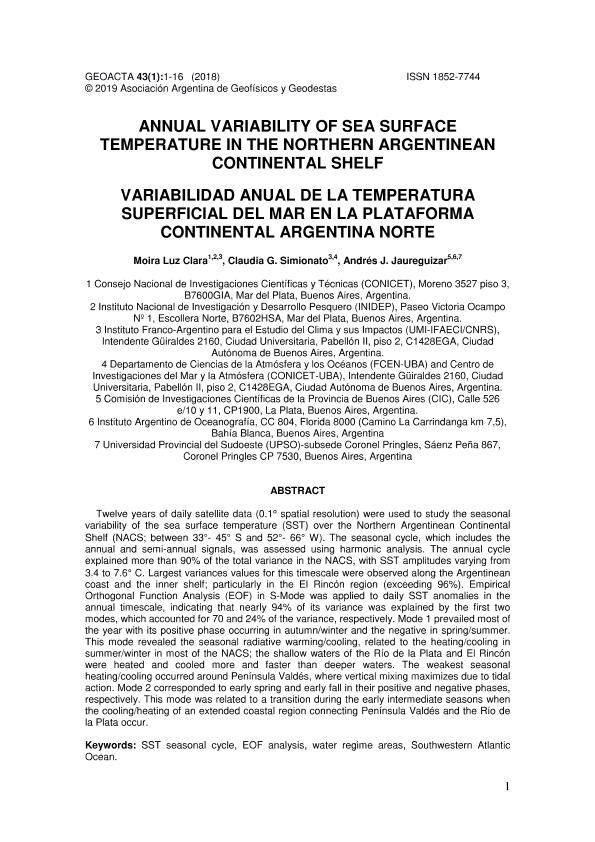Artículo
Twelve years of daily satellite data (0.1° spatial resolution) were used to study the seasonal variability of the sea surface temperature (SST) over the Northern Argentinean Continental Shelf (NACS; between 33°- 45° S and 52°- 66° W). The seasonal cycle, which includes the annual and semi-annual signals, was assessed using harmonic analysis. The annual cycle explained more than 90% of the total variance in the NACS, with SST amplitudes varying from 3.4 to 7.6° C. Largest variances values for this timescale were observed along the Argentinean coast and the inner shelf; particularly in the El Rincón region (exceeding 96%). Empirical Orthogonal Function Analysis (EOF) in S-Mode was applied to daily SST anomalies in the annual timescale, indicating that nearly 94% of its variance was explained by the first two modes, which accounted for 70 and 24% of the variance, respectively. Mode 1 prevailed most of the year with its positive phase occurring in autumn/winter and the negative in spring/summer. This mode revealed the seasonal radiative warming/cooling, related to the heating/cooling in summer/winter in most of the NACS; the shallow waters of the Río de la Plata and El Rincón were heated and cooled more and faster than deeper waters. The weakest seasonal heating/cooling occurred around Península Valdés, where vertical mixing maximizes due to tidal action. Mode 2 corresponded to early spring and early fall in their positive and negative phases, respectively. This mode was related to a transition during the early intermediate seasons when the cooling/heating of an extended coastal region connecting Península Valdés and the Río de la Plata occur. La variabilidad estacional de la temperatura superficial del mar (TSM) en la Plataforma Continental Argentina Norte (PCAN, entre 33º- 45º S y 52º- 66º O) fue estudiada a partir de doce años de datos satelitales de resolución diaria y 0,1° de resolución espacial. El ciclo estacional, que incluye las señales anuales y semianuales, fue evaluado mediante análisis armónico. El ciclo anual explicó más del 90% de la varianza total en la PCAN, con amplitudes de TSM que variaron entre 3,4 y 7,6 ºC. Los mayores valores de varianza para esta escala temporal se observaron a lo largo de la costa argentina y la plataforma continental interna, particularmente en la región de El Rincón (excediendo el 96%). Un análisis de funciones ortogonales empíricas (EOFs) en modo-S aplicado a las anomalías diarias de TSM en la escala anual indicó que casi el 94% de la varianza fue explicada por los primeros dos modos, que representaron el 70 y el 24% de la varianza, respectivamente. El Modo 1 prevaleció la mayor parte del año con su fase positiva en otoño/invierno y la negativa en primavera/verano. Este modo reveló el calentamiento/enfriamiento radiativo estacional, relacionado con el aumento/disminución de las temperaturas en verano/invierno en gran parte de la PCAN; las aguas poco profundas del Río de la Plata y El Rincón se calientan/enfrían más y más rápido que las aguas más profundas. El calentamiento/enfriamiento estacional más débil se produjo alrededor de Península Valdés, donde la mezcla vertical por acción de las mareas es intensa. El Modo 2 corresponde a principios de primavera y principios de otoño en sus fases positiva y negativa, respectivamente. Este modo se encontró relacionado con una transición durante el inicio de las temporadas intermedias, cuando se produce el enfriamiento/calentamiento de una larga región costera que conecta Península Valdés y el Río de la Plata.
Variabilidad anual de la temperatura superficial del mar en la plataforma continental argentina norte
Título:
Annual Variability of Sea Surface Temperature in the Northern Argentinean Continental Shelf
Fecha de publicación:
12/2018
Editorial:
Asociación Argentina de Geofísicos y Geodestas
Revista:
Geoacta
ISSN:
0326-7237
Idioma:
Inglés
Tipo de recurso:
Artículo publicado
Clasificación temática:
Resumen
Archivos asociados
Licencia
Identificadores
Colecciones
Articulos(CIMA)
Articulos de CENTRO DE INVESTIGACIONES DEL MAR Y LA ATMOSFERA
Articulos de CENTRO DE INVESTIGACIONES DEL MAR Y LA ATMOSFERA
Citación
Luz Clara Tejedor, Moira; Simionato, Claudia Gloria; Jaureguizar, Andrés Javier; Variabilidad anual de la temperatura superficial del mar en la plataforma continental argentina norte; Asociación Argentina de Geofísicos y Geodestas; Geoacta; 43; 1; 12-2018; 1-16
Compartir




